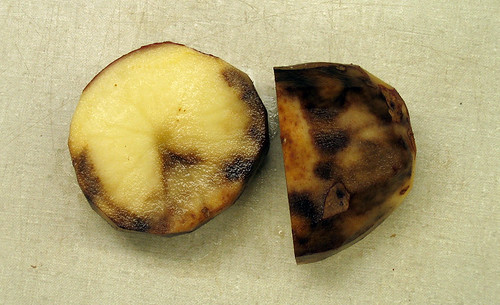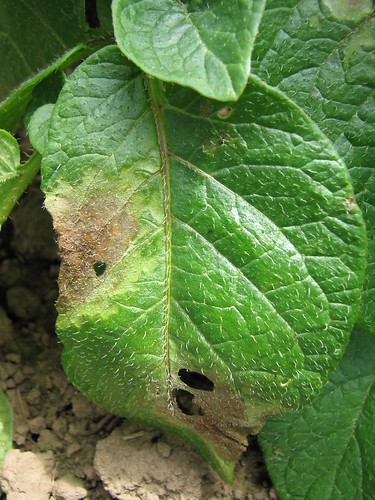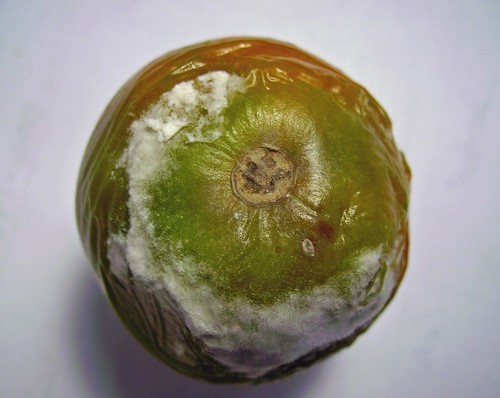
The following article was not written by TheGardenLady, but she thinks it’s a valuable one that the public should know about.
Irish Potato Famine Disease affecting Gardens and Farmers throughout the Greater Northeast
Revised by A. Wyenandt, NJAES, Rutgers University and M.T McGrath, Cornell University – Original article by Thomas A. Zitter, Cornell University, Ithaca, NY – Updated July 15, 2009
Late blight, caused by Phytophthora infestans, is a serious disease that affects tomato plants and potato plants around the world.

Late blight can become a serious problem because it can quickly kill affected plants and its spores are easily carried in wind currents to infect other susceptible plants in even the most remote areas in our region.
Late blight occurs sporadically in the Northeast in any given year because farmers diligently use methods to prevent the pathogen from surviving overwinter. Since our summer thus far has been cool with frequent rains, weather conditions have been very conducive for late blight development.

Currently, all tomato and potato plants grown in home gardens and in commercial fields are susceptible to late blight!
Commercial growers are able to respond to reports of the disease by spraying fungicides to prevent its spread, which otherwise would mean certain death of their entire crops. Unfortunately, many homeowners may not be as aware of this important disease, and if no corrective actions are taken in a timely manner, home gardens can provide a source of inoculum (i.e. spores) for their neighbor’s gardens and for commercial interests.
The occurrence of late blight in 2009 is different compared to most seasons. This is the earliest the disease has been reported over such a broad region of the country. More tragic for the Northeast, is that infected plants have been distributed to large local retail stores throughout the region (Ohio to Maine). Never before has such an extensive distribution of infected plants occurred.
The inoculum is exceptionally contagious, thus it has most likely spread on garden center shelves to tomato plants which were not involved in the original and initial source of the inoculum. In recent days, vegetable pathologists throughout the Northeast have found the disease in stores and spread the word of this potential disaster, and within days the original supplier, working with Department’s of Agriculture in the affected states, had begun to remove most of the infected plant material.
What to do now? Given the tough economic times, many families in the Northeast have taken up vegetable gardening, and tomato is one of the most planted crops in home gardens. Late blight is not seed-borne (however, it is tuber-borne in potato), so that tomato plants started from seed locally would be free of the disease, at least for now. Given the scenario, one must assume that many infected tomato plants have been planted across the entire Northeast region. Of particular concern are tomato plants purchased at retail locations where plants are being marketed that originated from a wholesaler that has late blight. Locations with affected tomatoes identified so far have been the “big box” stores.
Identification: The symptoms that develop on tomato leaves, stems and fruit are quite dramatic, and are very obvious to the naked eye. The leaf lesions are water-soaked, varying in size from a nickel up to a quarter. They are water-soaked when the foliage has been exposed to watering or heavy overnight dews. When these lesions dry out quickly, they may appear lime-green in colored or even become beige. Late blight lesion on infected tomato leaf at garden center and in a home garden. The edge of the water-soaked lesion, on either the top or bottom leaf surface, will be covered with white fungal growth that contains the spore inoculum (visible with a hand lens). Spores are easily blown to surrounding areas and infect plants and even some weed species in the family Solanaceae (the black nightshade family). Brown to almost black lesions develop on infected stems, and the same lesions will develop on infected fruit, either directly on the plant, or a few days after when they are sitting on a kitchen counter. Since it is not dangerous to humans, most of the fruit could be used if the affected area is removed.
Plant examination and removal: Please inspect your tomato plants on a daily basis! If symptoms are already appearing on plants in your garden, these plants should be removed and put in a plastic bag for disposal. Do not put the removed plants in a compost pile, as spores can still spread from the debris. Your neighbors, not to mention commercial growers, will appreciate
you taking this action immediately.
Plant treatments: Commercial growers have a number of fungicides that if applied early and often, can reduce the spread of Late blight. They would choose not to spray if they could, but this destructive disease does not give them any other option. Homeowners do have a few products that are registered for use; the most effective ones have the common name of chlorothalonil which will be on the label. These products are only effective if used before the disease appears and should be reapplied every 5-7 days if cool, wet weather persists. Chlorothalonil is a protectant fungicide, with no systemic movement in the plant, so thorough coverage is necessary. Copper applications are not as effective as chlorothalonil.
Diagnostic Services: For those homeowners interested in getting diagnostic testing for late blight on tomato or other diseases on vegetables in their garden, please contact your state university’s plant diagnostic lab service. (These diagnostic services, in most states, require a fee.) It is critical to get potential Late Blight samples to the diagnostic clinic as quickly as possible. Laboratories may be able to fax or e-mail results within 24 hours. New Jersey residents can submit samples to Rutgers Plant Diagnostic Lab. New York State residents can submit samples to Cornell Plant Disease Diagnostic Clinic or the the chat room Q&A:
